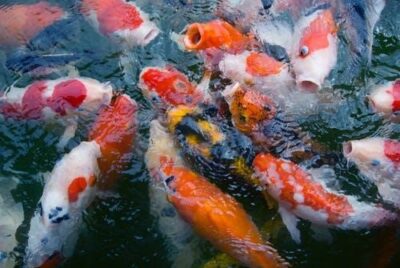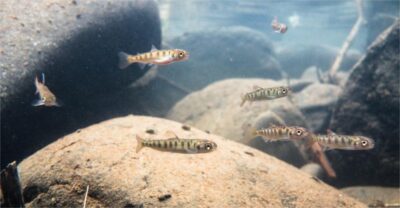Understanding how should you feed fish in the pond and how much should you feed them is a common query every pond owner have in his mind. Pond Fish, like all animals, need to be fed. Providing them with the food they need will keep them healthy and maintain good water quality for as long as possible.
To ensure that your pond fish is taking feed properly, you need to take certain essential precautions. Also, you must know when to feed them and, depending on their species, provide them with the nutrients they essentially need.
Understanding Fish Nutrition, Feeding and Types of Feed
In animal production systems, good nutrition is critical for the cost-effective production of a nutritious, high-quality commodity. Nutrition is important in fish farming (aquaculture) because feed accounts for roughly half of the variable output expense.
With the introduction of fresh, healthy commercial diets that support optimum fish growth and wellbeing, fish nutrition has improved significantly in recent years. The invention of new species-specific diet formulations aids the aquaculture industry’s expansion to meet the rising demand for inexpensive, nutritious, high-quality fish and seafood.
What Nutrients Do Your Fish Need?
It is important to know what species of fish are in your pond. Indeed, fishes are different from each other. For each fish, there is an appropriate food.
Also, depending on their species and lifestyle, some types of fish often feed on the surface of the pond. At this level, by selecting solid foods that do not stay on the surface, these fish may stay hungry and die. Similarly, other fish are deep-sea fish and do not like to feed on the surface. This is the case of sturgeon, for example, which prefer to feed at depth. This specificity can help you to avoid that the fish in the pond are not underfed or simply starving.
As far as food is concerned, some fish prefer mosquito larvae and duckweed. Knowing the feeding habits of fish will allow you to recommend a regular and quality food ration for their biological balance and for their good health. Beyond the quality and the quantity to give to the fish, you must know when to feed them?
● Commercial Feeds
Artificial feed is a full or supplementary source of nutrition. Complete diets have all of the nutrients (protein, carbohydrates, fats, vitamins, and minerals) that the fish need for optimum growth and health. Most fish farmers feed full diets, including protein, lipids, carbohydrates, ash, phosphorus, water, and trace amounts of vitamins and minerals in various percentages. The nutritional value of the feed varies depending on the species and life cycle of the fish. On the other hand, supplemental diets are famous to replace the natural food available to fish in ponds or outdoor raceways.
● Proteins
The most costly part of fish feed is fish protein. Of the more than 200 amino acids found in nature, only about 20 are popular. Ten of these are important (non-negotiable) fish amino acids are not coming from food. Methionine deficiency is common in fish feeds with plant protein, and methionine and lysine deficiency are common in fish feed with bacterial proteins. When these protein products act as a substitution for fishmeal, these amino acids must be replaced. Smaller fish, as well as those in their early stages of development, have higher protein needs. Fish’s protein needs usually reduce as they become larger.
● Lipids
Lipids (fats) are high-energy carbohydrates famous in aquaculture feeds to partly spare (substitute for) protein. Lipids contain about half as much energy as proteins. Protein and carbohydrate content are also large. Lipids are a type of lipid present in supply about 7-15 percent of fish diets. Transporters for fat-soluble vitamins and essential fatty acids. Higher amounts of phosphorus have recently become common in fish feeds. Dietary lipids are a form of fat that is already there in many foods. Although increasing dietary lipids can be beneficial, you can help reduce the high cost of meat by partly sparing. problems of extra fat in the feed, protein in the feed Deposition in the liver can affect the health and efficiency of fish and the finished product’s shelf life
● Carbohydrates
Carbohydrates (starches and sugars) are the most cost-effective energy sources for fish. Carbohydrates in aquaculture diets minimize feed costs and their binding activity during feed manufacturing. Dietary starches are useful in the production of floating feeds by extrusion. Cooking starch makes it more biologically viable to fish during the extrusion phase. Carbohydrates are processed as glycogen in fish, mobilising is possible to meet energy demands. They are a significant source of nutrition for mammals, but fish do not use them effectively. Mammals, for example, can get around 4 calories out of 1 gram of carbohydrate, while fish can only get around 1.6 calories out of the same amount of carbohydrate. Fish will consume up to 20% of the carbohydrates in their diet.
● Vitamins
Vitamins are organic compounds that are essential in the diet in order for fish to develop and stay healthy. Vitamin C is the most essential of these since it is a potent antioxidant that helps fish and shrimp’s immune systems. Water-soluble and fat-soluble vitamins are the two types of vitamins. Vitamin E is the one that gets the most coverage because of its essential antioxidant properties. Vitamins E and C also help to extend the shelf life of foods by inhibiting dietary lipid oxidation.
● Minerals
It is important to consume minerals as inorganic elements for the body to function normally. Fish absorbs minerals through their gills and skin directly from the water. Based on the quantity needed, they can be classified into two categories: macrominerals and microminerals. The number of minerals in fish is determined by the number of minerals found in the fish and the water temperature. These minerals help with bone structure and integrity by regulating osmotic equilibrium. Iron, copper, chromium, iodine, manganese, zinc, and selenium are common microminerals.
Types Of Feed
Extruded or pressure-pelleted feeds are used to make commercial fish diets. While both floating and sinking feeds may produce adequate development, some fish species prefer floating while others prefer sinking. Most fish species can be conditioned to accept a floating pellet, but shrimp, for example, may not accept it.
Because of the higher processing prices, extruded feeds are more costly. Feeding a floating feed is usually beneficial since the farmer can directly monitor the feeding strength of his fish and change feeding rates if required. When it comes to optimizing fish growth and feed production, determining if feeding rates are too low or too high is critical.
How Much Should I Feed Fish In The Pond?
Another criterion to consider, and not the least, beyond quality, is the amount of food given to the fish. Fish should be fed sparingly, which reduces the risk of excess food settling to the bottom of the pond. This reduces the risk of excess food settling at the bottom of the pond. When food is given in abundance, the fish will only take in what they need, and the rest will turn into debris that will foul the pond. If the pond water is contaminated, the filtering properties of the pond can be reduced, and the risk of pollution increased. If the pond water is polluted, the fish may die or be affected by certain diseases.
When Should You Feed Fish In The Pond?
Fish, like all living organisms, do not have the same needs. Some of them have a resting period during winter; the quantities of food must be adapted to this rather peculiar way of life. On the other hand, others like sturgeon, very comfortable in winter, must continue to receive the same food ration.
The temperature level also has an impact on the feeding of the fish in the pond. When temperatures are low, i.e., below 8°C, most fish enter their lethargy period; it is recommended not to feed them. Abundant feeding in this situation will lead to pollution and fouling of the water. However, when the temperature rises but does not exceed 12°C, it is advisable to start feeding the fish in the pond again gradually. Two to three times a week is sufficient for a balanced diet.
Above 15°C, the ratio can become daily. Similarly, if the fish are in the reproduction period, the food requirements can be more or less important. Some fish may prefer daytime feeding, while others are fond of daytime feeding. These are some of the things you need to consider to ensure that your pond inhabitants are well fed.
To feed your pond fish, you don’t need to be a fish expert, a little reading and a few tips will allow you to care for your aquatic animals effectively.












Pingback: How To Keep Pond Water Clean For Fish - Aquigarden.com